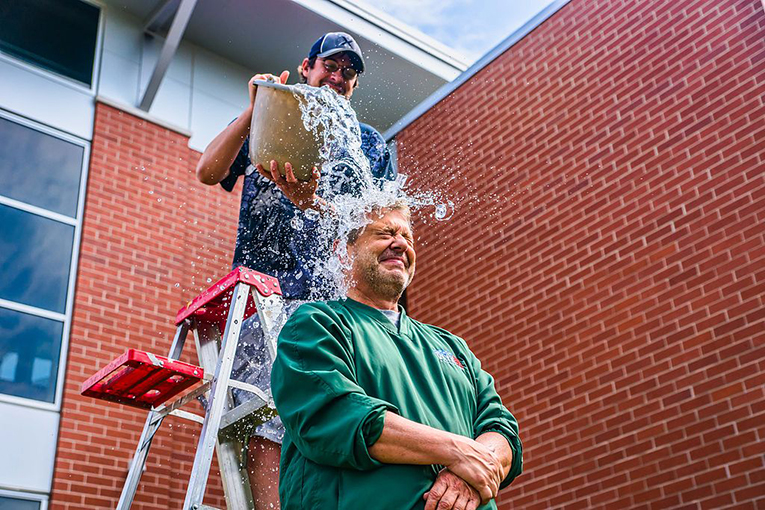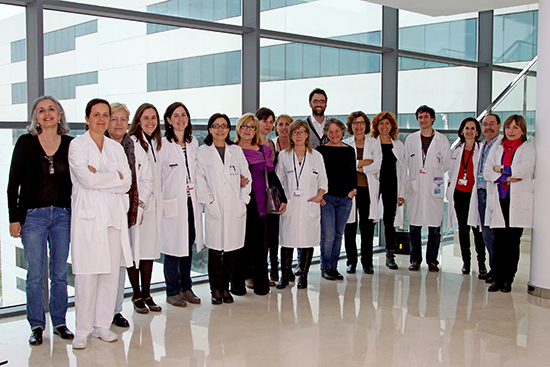
|
|
||||
|
Suddenly. That is how an ALS patient realises that his life has completely changed and there is no turning back. Suddenly, an ALS patient becomes a part of an unknown, hard world that involves many problems and very little social concern. Fears of rejection and deterioration fill the mind of the patient that suffers from a confusing disease from which there is no escape. Amyotrophic lateral sclerosis is a neuromuscular degenerative disease by which motor neurons (neurons that intervene in the voluntary movement of muscles) gradually stop functioning and die, thereby causing a progressive muscular paralysis. It means the loss of nerve fibres accompanied by hardening or scarring (sclerosis) of the lateral area of the spinal cord. Amyotrophic, on the other hand, refers to the muscle atrophy that occurs due to the inactivity of the muscles when they do not receive nerve signals. These nerve cells can be found both in the brain and in the spinal cord, but the disease does not affect neither the senses nor the intellect; thus, the patients are perfectly aware of their situation until the end. Some, seeing themselves in this living hell, try to get individual salvation, but that is precisely the force that has allowed ALS to move unstoppably forward. The term ALS was first used by French doctor Jean Martin Charcot in 1874, and from then on this disease has been universally known as ‘Charcot’s disease’. The average age of the patient is between 40 and 70, although there are younger patients, and more men than women have this disease. In Spain, it is estimated that each year 900 new cases are diagnosed, and the number of affected people remains stable at about 4,000, due to the disease’s mortality rate. There are about 350,000 people affected by this disease which kills 100,000 people a year worldwide. But what are the symptoms of ALS? It is difficult to find an answer, since there are many symptoms that vary from one person to another, and they mimic those of other diseases. Fatigue, trembling and not being able to lift her left hand’s index finger were Cati Salom’s. Tobías Calvo, however, started to notice instability in his walk and fell repeatedly due to the lack of strength, while Joaquín Fita started to get tongue-tied when he tried to pronounce some words. Consuelo Sancho noticed tremors in her left hand’s fingers and Concha Garcés started with her voice, since she could not speak well. The cases are sporadic and can affect anyone regardless of their health, age and lifestyle, so there is no way to prevent it. However, all of these patients agree on one thing: none of them knew anything about ALS until they were diagnosed with it ADELA, working for hope The Spanish Association of Amyotrophic Lateral Sclerosis (ADELA or adEla) was founded in May 1990 in Madrid, with the collaboration of other countries. The branch in the Valencian region started a little later, in November 1991, thus becoming the first autonomous community ever to create one with the need to work closer to the patients. The first steps in the path of the ADELA-CV, association –which is currently an independent entity despite having kept its initials and collaborating with the original association in many aspects– were taken by Javier Ruiz, which was affected by the disease, with the aim of giving voice to a collective that is unprotected for suffering an little known condition. According to the figures handled by ADELA-CV, in the Valencian region there are about 400 patients with ALS, and of these, 337 people are associated with this entity and 185 keep in constant contact with it. Bárbara Chiralt, a social worker from the association, admits that there are now about a hundred cases only in the province of Valencia, whereas when they started that was the total number of the whole region. «There are those who contact us and those who do not, and I do not think it is due to ignorance, but to fear or the expectation of ‘why do it if there is no cure’. Sometimes the despondency the disease entails makes some people shut themselves in their homes, live in subhuman conditions… Anything but facing what is happening and search for solutions», she claims. This association’s motto is «Working for hope», words that translate into a constant support to all patients, thus trying to make the patients see that they are not alone, and ensuring that they receive support throughout all they are facing. «This disease is very hard from the beginning, but also throughout its evolution», explains Bárbara Chiralt. ADELA-CV also conducts activities that try to make the patients help each other, in order to escape from the isolation caused by being affected by a rare disease; they don’t usually know others that share their problem. Another type of activities include training caregivers as well as those affected by the disease, focusing on knowing how to deal with the problems they are faced with, like communication or the nursing treatment. ALS is a disease that causes social problems, and the greater support comes from people close to the patients, from their family. «Sometimes it is a family with resources and means, who can handle it well, but for most it is a complicated issue, with relatives who have to stop working or with patients with lacks that end up reducing their aspirations of improvement because their needs exceed those estimated », claims this social worker. That is why from the association they work so that the patients have an easier access to that aid, as well as to the elements that become necessary through the evolution of the disease, such as articulated beds, cranes or chairs. Thus, ADELA-CV has a deposit of materials that lends to all those who cannot afford them by themselves since they are not affordable products. |
«ALS is a neuromuscular degenerative diseases that causes progressive brain paralysis»
«Sometimes the despondency the disease entails makes some people shut themselves in their homes, live in subhuman conditions… Anything but facing what is happening and search for solutions»
|
|||
|
|
||||
|
ALS, A CHALLENGE TO OVERCOME Having ALS is expensive. Bárbara Chirald carried out a study that analysed the expenses a patient could afford with an average income of 900 or 1,000 euros. «If he needs to move to another house, buy a bed or look for someone to help him he would not be able to cover even half of his basic needs with what is left», she claims. Most patients want to be near their family despite the sacrifice it means for them, which experts consider a more ideal situation. But, how does ALS affect a person? Carlos Matallanas, a 30 year old football player and journalist, was diagnosed a year and a half ago. Since last October he has a blog in El Confidencial, My battle against ALS, where he portrays the daily life of his disease. Carlos explains that «fear can grab a hold of you, and you have to be level-headed and calmly look at everything, being sure about feeling comfortable at any moment». He claims that the hardest thing is «seeing those you love suffering, even more you». For his part, Jano Galán, 37, married and father to three children, has lived with ALS for two and a half years. Jano, like Carlos, is an example of improvement and joie de vivre. He opened a website, DGeneración, with which he wants to tell what is happening, not to set an example, but to show how the disease is like, sending an encouraging message. DGeneración, in addition, is an engine to raise funds for research and awareness. Carlos Salas was on the other side. His 40 year old wife, Ana, died of ALS. Together they travelled to Toledo, Madrid, Zaragoza and Valencia, and he admits that at first «you have hope». «My wife was fine, until one day she dragged her leg, it did not hurt, she just dragged it». That was the start of a journey of three months between traumatologists and neurologists that prescribed her medication even before getting a final diagnosis. It has been ten years, but Carlos remembers his wife’s bravery, his family’s, his daughters’ and his own. «The day my wife died I went home with my daughters, and the next day I took them to school, as if nothing had happened. Four and a half years of suffering is a lot of time to get used to the idea». The «damned disease», as Carlos calls it, took his wife, and with her, a part of his life. In recent years, charities have started to operate with the aim of contributing to make this rare disease more visible. Undoubtedly, the most important one has been the Ice Bucket Challenge, which originated in the United States and which was promoted here by the Spanish association of amyotrophic lateral sclerosis, which managed to raise a total sum of €376,000 through more than 12,000 donations. Specifically, ADELA-CV managed to raise €9,600 to fight a disease was completely unknown for most of society due to its low prevalence and high mortality rates until recently. For now there is no treatment that has proved effective against ALS, but despite being, for now, an incurable disease, there are four main lines of research according to the Spanish Guide for the Treatment of ALS, prepared by the Department of Health: drugs, neurotrophic factors, gene therapy and stem cells. With regards to the former, no drug or new molecule has proved effective. The second have spread hope in the preclinical stage thanks to the VEGF protein (Vascular Endothelial Growth Factor), which protects the motoneuron or motor neuron. Gene therapies aim at interfering in the course of the disease through the modification of certain genes. In Valencia, La Fe University and Polytechnic Hospital has, since last year, an ALS Multidisciplinary Unit with 23 specialists and an average of 150 patients, which has become a point of reference in comprehensive assistance to patients with amyotrophic lateral sclerosis and which also promotes clinical research and communication. This hospital coordinates with the Unit in Castellón’s General Hospital, which also treats ALS cases. On the other hand, in the Miguel Hernández University of Elche, another research project with stem cells has that looks for treatments that can stop this disease has started. Neuroscience is very complex and although it has existed for many years, it is not as advanced as other branches of medicine. For now, what we have to do is to come to terms with a disease that will accompany those it affects for the rest of their lives, and with which they must consider aspiring to a good life quality. Currently we do not have enough tools to win this fight. |
«In recent years, charities have started to operate with the aim of contributing to make this rare disease more visible. Undoubtedly, the most important one has been the Ice Bucket Challenge»
«What we have to do is to come to terms with a disease that will accompany those it affects for the rest of their lives, and with which they must consider aspiring to a good life quality»
|
|||
|
||||
|
José Luis Lagardera, Andrea Pastor and Miriam Salvador. Students of Journalism at the University of Valencia. |
|
|||









